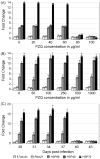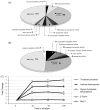Towards an understanding of the mechanism of action of praziquantel
- PMID: 19100294
- PMCID: PMC2886009
- DOI: 10.1016/j.molbiopara.2008.11.007
Towards an understanding of the mechanism of action of praziquantel
Abstract
Although praziquantel (PZQ) has been used to treat schistosomiasis for over 20 years its mechanism of action remains unknown. We have developed an assay based on the transcriptional response of Schistosoma mansoni PR-1 to heat shock to confirm that while 6-week post-infection (p.i.) schistosomes are sensitive to PZQ, 4-week p.i. schistosomes are not. Further, we have used this assay to demonstrate that in mice this sensitivity develops between days 37 and 40 p.i. When PZQ is linked to the fluorophore BODIPY to aid microscopic visualization, it appears to enter the cells of intact 4 and 6-week p.i. schistosomes as well as mammalian NIH 3T3 cells with ease suggesting that the differential effects of PZQ is not based on cell exclusion. A transcriptomal analysis of gene expression between 4 and 6 weeks p.i. revealed 607 up-regulated candidate genes whose products are potential PZQ targets. A comparison of this gene list with that of genes expressed by PZQ sensitive miracidia reduced this target list to 247 genes, including a number involved in aerobic metabolism and cytosolic calcium regulation. Finally, we also report the effect of an in vitro sub-lethal exposure of PZQ on the transcriptome of S. mansoni PR-1. Annotation of genes differentially regulated by PZQ exposure suggests that schistosomes may undergo a transcriptomic response similar to that observed during oxidative stress.
Figures





Similar articles
-
Transcriptomic analysis of reduced sensitivity to praziquantel in Schistosoma mansoni.Mol Biochem Parasitol. 2019 Mar;228:6-15. doi: 10.1016/j.molbiopara.2018.12.005. Epub 2019 Jan 15. Mol Biochem Parasitol. 2019. PMID: 30658180 Free PMC article.
-
Transcriptional analysis of Schistosoma mansoni treated with praziquantel in vitro.Mol Biochem Parasitol. 2012 Dec;186(2):87-94. doi: 10.1016/j.molbiopara.2012.09.006. Epub 2012 Sep 27. Mol Biochem Parasitol. 2012. PMID: 23022771 Free PMC article.
-
Synergy of Omeprazole and Praziquantel In Vitro Treatment against Schistosoma mansoni Adult Worms.PLoS Negl Trop Dis. 2015 Sep 24;9(9):e0004086. doi: 10.1371/journal.pntd.0004086. eCollection 2015. PLoS Negl Trop Dis. 2015. PMID: 26402251 Free PMC article.
-
Activation of transient receptor potential channel Sm.(Schistosoma mansoni)TRPMPZQ by PZQ, enhanced Ca++ influx, spastic paralysis, and tegumental disrupture-the deadly cascade in parasitic schistosomes, other trematodes, and cestodes.Parasitol Res. 2020 Aug;119(8):2371-2382. doi: 10.1007/s00436-020-06763-8. Epub 2020 Jun 30. Parasitol Res. 2020. PMID: 32607709 Free PMC article. Review.
-
Praziquantel: An update on the mechanism of its action against schistosomiasis and new therapeutic perspectives.Mol Biochem Parasitol. 2022 Nov;252:111531. doi: 10.1016/j.molbiopara.2022.111531. Epub 2022 Nov 11. Mol Biochem Parasitol. 2022. PMID: 36375598 Review.
Cited by
-
Antischistosomal activity of trioxaquines: in vivo efficacy and mechanism of action on Schistosoma mansoni.PLoS Negl Trop Dis. 2012;6(2):e1474. doi: 10.1371/journal.pntd.0001474. Epub 2012 Feb 14. PLoS Negl Trop Dis. 2012. PMID: 22348155 Free PMC article.
-
Transcriptional responses of in vivo praziquantel exposure in schistosomes identifies a functional role for calcium signalling pathway member CamKII.PLoS Pathog. 2013 Mar;9(3):e1003254. doi: 10.1371/journal.ppat.1003254. Epub 2013 Mar 28. PLoS Pathog. 2013. PMID: 23555262 Free PMC article.
-
Genetic knockdown and pharmacological inhibition of parasite multidrug resistance transporters disrupts egg production in Schistosoma mansoni.PLoS Negl Trop Dis. 2011 Dec;5(12):e1425. doi: 10.1371/journal.pntd.0001425. Epub 2011 Dec 6. PLoS Negl Trop Dis. 2011. PMID: 22163059 Free PMC article.
-
Design and synthesis of molecular probes for the determination of the target of the anthelmintic drug praziquantel.Bioorg Med Chem Lett. 2014 Jun 1;24(11):2469-72. doi: 10.1016/j.bmcl.2014.04.014. Epub 2014 Apr 13. Bioorg Med Chem Lett. 2014. PMID: 24775301 Free PMC article.
-
Schistosome ABC multidrug transporters: From pharmacology to physiology.Int J Parasitol Drugs Drug Resist. 2014 Sep 26;4(3):301-9. doi: 10.1016/j.ijpddr.2014.09.007. eCollection 2014 Dec. Int J Parasitol Drugs Drug Resist. 2014. PMID: 25516841 Free PMC article. Review.
References
-
- Cioli D, Pica-Mattoccia L. Praziquantel. Parasitol Res. 2003;90:S3–9. - PubMed
-
- Andrews P. Effect of praziquantel on the free living stages of Schistosoma mansoni. Z Parasitenkd. 1978;56:99–106. - PubMed
-
- Liang YS, Coles GC, Doenhoff MJ, Southgate VR. In vitro responses of praziquantel-resistant and-susceptible Schistosoma mansoni to praziquantel. Int J Parasitol. 2001;31:1227–35. - PubMed
-
- Mattos ACA, Kusel JR, Pimenta PFP, Coelho PMZ. Activity of praziquantel on in vitro transformed Schistosoma mansoni sporocysts. Mem Inst Oswaldo Cruz. 2006;101(Suppl 1):283–7. - PubMed
-
- Gönnert R, Andrews P. Praziquantel a new board-spectrum antischistosomal agent. Z Parasitenkd. 1977;52:129–50. - PubMed
Publication types
MeSH terms
Substances
Grants and funding
LinkOut - more resources
Full Text Sources
Other Literature Sources
Molecular Biology Databases
Research Materials

